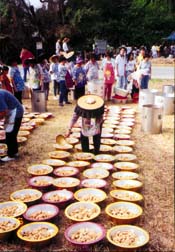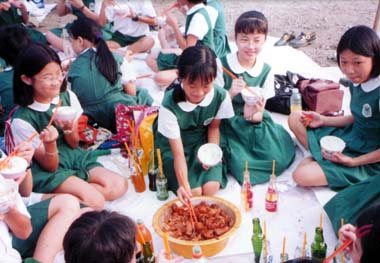|
A taste of local tradition In the New Territories, pun choi evokes memories By Vivian To |
|
From time to time, the villagers of Sheung Shui Tsuen go to worship their ancestors on special days such as the Ching Ming and Chung Yeung Festivals. After the ceremonies, there is a feast in the countryside for descendants of the deceased to enjoy themselves. Since the villagers have to walk a long distance to their ancestral tombs, dividing the food into small portions in many containers made it very heavy and troublesome to carry. |
Vivian To
|
|
“In order to be more convenient,” said Mr. Liu, “they brought buckets of pre-cooked food to the tombs and distributed it on the spot using basins.” Aside from times of communal worship, pun choi is eaten at weddings and birthday banquets for the newly born and the elderly. “In the past, people had shorter lives, owing to malnutrition and hard work. “If a person died after 61 years of age, it was considered a blessing, and his descendents would eat pun choi after his funeral, hoping for longevity,” said Mr. Liu. Although villagers still stick to traditional practices, pun choi has been changing as time goes by. For instance, the original wooden basins, which broke easily and were difficult to wash, have been replaced by more durable and lighter metal ones. There has also been a change in the ingredients. “People have become more choosy about what they eat, especially as they got richer. “Besides basic ingredients like turnips, fried pork skin, beancurd puffs, beancurd skin and squid, more expensive ingredients are added now, such as chicken, duck, roast pig, prawns and dried eel,” said he. One main characteristic of pun choi is that the food is arranged in layers. According to Mr. Wat Shun-chung, a pun choi expert in Yuen Long who runs a business that caters pun choi banquets, there is a special reason for this arrangement. “All the ingredients have their distinct flavours. It would be odd if they were mixed together,” said he. The order in which food is placed in the basins is also important. Food with thick sauces and strong flavours is placed at the top, so that the sauces can penetrate down through the layers. Nowadays, pun choi is not enjoyed only by villagers in the New Territories. Many Chinese restaurants, such as the Lung Wah Hotel Chinese Restaurant in Sha Tin, now serve pun choi to the general public. To suit the tastes of customers, the restaurant has made some modifications to the original recipe. “We don’t use dried eel, because it has a lot of bones and tastes rather strange,” explained Mr. Wan Kuen-chun, supervisor of the restaurant. “We replaced it with fishballs, so that even children and old people can eat the pun choi easily.” Also, crock pots instead of metal basins are used to serve the food. “It keeps the food warm and has a stronger country style,” said he. The response from customers has been good. Said Mr. Wan: “Many customers bring their families and friends here to eat pun choi. “We’ve even had foreign customers who came from far away just to try this special cuisine.” Miss Lai Mei-chu, a 25-year-old electronic technician, tried pun choi for the first time with her family. Said she: “Pun choi is very new to me and I rarely have the chance to eat it elsewhere in the city. “I’ll definitely recommend pun choi to others,” she added. However, Mr. Wat Shun-chung described the “modern” pun choi as “unorthodox” and “totally different from the traditional pun choi.” “Of course people say this kind of pun choi is delicious,” said he, “because the restaurants all use expensive ingredients like seafood — even abalone. “But modern pun choi can never replicate the unique taste we experienced in its traditional style,” he said. Mr. Wat said that people who know pun choi can tell the real thing from the imitations just by looking at it and smelling it. “Most restaurants add ordinary seasonings and artificial flavours,” he said. |
Vivian To |
|
A big difference between modern and traditional pun choi is the process of preparing and cooking the meal. In ordinary restaurants, pun choi is served hot, immediately after cooking. But the finest pun choi must be left for hours, preferably overnight, before serving, according to Mr. Wat. “Then the essences from the ingredients will be forced out and you can smell the strong odour even across the street.” Mr. Wat predicted that the trend of eating pun choi will soon peak. “After they’ve tried it once, city dwellers lose interest in the cuisine,” he said. “They’re also pretty concerned about healthy diets and avoid eating too much greasy food.” But he is not worried about the prospects for his business. “We have villagers as our basic customers, and their demand for pun choi will always exist. “For example, new couples from the village are still required by village rules to hold pun choi banquets when they get married.” The market is big indeed, covering villages in Sheung Shui, Fanling, Yuen Long and Tai Po. When he gets an order, Mr. Wat and his workers transport the cooking utensils and the food by truck to the village where the banquet is being held. Then they lay all the basins on the ground and distribute the food layer by layer. This spectacular process is called da pun, which means “hit the basin”, and it usually attracts many curious spectators. But no matter when and where pun choi is eaten, it has special meaning to the villagers. Said Mr. Liu of Sheung Shui Tsuen, “As everyone goes outside (of the village) to earn a living now, we seldom see each other. “Having pun choi banquets provides us an opportunity to maintain close relationships and binds us together. “Maybe this was the intention of our ancestors in leaving us such a tradition to follow,” Mr. Liu said. |
 Astrology
Astrology
December 1997
[Editorial] [Letters] [Answer] [News] [Social] [Photo] [Culture] [Education] [Channels] [Science] [Celebrity]
Comments Editor-in-Chief Electronic Editor